Technology Category
- Platform as a Service (PaaS) - Application Development Platforms
Applicable Industries
- Life Sciences
- National Security & Defense
Applicable Functions
- Quality Assurance
- Sales & Marketing
Use Cases
- Leasing Finance Automation
- Material Handling Automation
Services
- Testing & Certification
About The Customer
Dassault Systèmes is a science-based company that provides solutions for innovation drawn from various fields such as mathematics, biology, chemistry, physics, and geology. For 40 years, the company has helped thousands of manufacturers reinvent their development and production methods to enable sustainable innovation. Their 3DEXPERIENCE platform is a system of operations designed to run, model, and transform a business. The company operates in over 20 different markets and heavily relies on LinkedIn lead generation forms to acquire new customers.
The Challenge
Dassault Systèmes, a global software company, relied heavily on LinkedIn lead generation forms (LGF) to acquire new customers. They ran high volumes of campaigns from over 20 different markets. The challenge was to convert this campaign information into usable datasets for the sales team, which involved manually collecting and transforming the data. Each dataset had to be downloaded, formatted with tracking, and imported into Adobe Campaign, a process that took more than 10 days to complete. This time-consuming process hindered the company's ability to move quickly. Additionally, the lead forms contained personally identifiable information (PII), which required prioritizing customer security, adding to the complexity of handling the data. With such demanding data complexities, Dassault Systèmes needed a faster and more efficient solution to save time and produce usable, accurate data.
The Solution
Dassault Systèmes turned to Adverity's LGF data connector to automate the collection of their LinkedIn information in bulk. This solution included the ability to take raw data and instinctively assign a new field to its respective country, such as Germany or the UK. Adverity's robust solution freed the team from having to spend time on data translation, allowing their resources and manpower to be better spent on business-driving projects. The operational enhancements meant the data was collected, transformed, enhanced, and then sent to their S3 data lake and then uploaded to Adobe. With a platform to handle laborious tasks, the team increased workflow performance and data accuracy.
Operational Impact
Quantitative Benefit

Case Study missing?
Start adding your own!
Register with your work email and create a new case study profile for your business.
Related Case Studies.

Case Study
Data Capture for Afghanistan Forces
Electronic equipments on the field of Afghanistan provided information on the status of the vehicle and to identify potential threats surrounding it to the British Force. The monitoring and interpretation of this data requires robust and sophisticated digitization for data capture and communication.

Case Study
Corporate Identity Solution Adds Convenience to Beckman Coulter
Beckman Coulter wanted to implement a single factor solution for physical and remote logical access to corporate network. Bechman Coulter's users were carrying smart card badges for doors, but also needed a one-time password token to access to our corporate network when they were not in the office. They wanted to simplify the process.
Case Study
Enhancing Security and Compliance in Remitly's Global Money Transfer Service with Fastly
Remitly, an online remittance service, was faced with the challenge of securing its proprietary global transfer network. The company needed a security solution that could meet PCI requirements and protect customers' sensitive transactions through its mobile application. The solution had to be capable of defending against new and emerging attack types without impacting performance. Remitly also had to deal with irregular traffic patterns, such as a sudden spike in account transfers from a small network segment on the Pacific coastline of South America. The company needed to determine in real time whether such traffic indicated an attack or valid requests. A traditional web application firewall (WAF) would not be able to distinguish this traffic, potentially leading to customer frustration if the IP was blacklisted.

Case Study
Embracing Business Success in Real Time
· Increase control over growing Big Data to improve business decisions · Manage data for 28,000 biotechnology stockkeeping units in the fields of microbiology, molecular biology, animal cell cultures, plant tissue cultures, and lab ware for laboratory chemicals · Accelerate report generation and analysis with real-time data

Case Study
Major Aerospace Company Automates Asset Management
The O&M division of an aerospace and global security company was using spreadsheets to manually track more than 3,000 assets assigned to students and staff. Maintaining audit trails for this high volume of equipment became increasingly time-consuming and challenging. The chore involved knowing precisely what equipment was on hand, what had been issued, its location and the name of the custodial owner of each item. Every aspect of this task was carried owner of each item. Every aspect of this task was carried out by individuals with spreadsheets. Manually documenting the full lifecycle of each asset added to the burden. This included tracking maintenance requirements and records, incidents and damages, repairs, calibrations, depreciation, and end-of-life data.

Case Study
Securing a Large Data Center in the EMEA Region: An IoT Case Study
A leading data-center operator in the EMEA region, with multiple facilities spanning over 25,000 square meters, faced significant security challenges. The operator experienced interruptions in their internal IT network due to unsupervised work of third-party technicians. Despite having a high-end building control system that provided 24x7 monitoring and control to all the building’s infrastructure, the data center was vulnerable from a cyber perspective as it was connected to the IT network infrastructure. The operator launched an urgent OT cyber security project that included both IT-OT network segmentation and OT network asset mapping and anomaly detection. The main objectives were to harden the security of the server systems, secure the facility’s power supply and server cooling system, strengthen the segmentation between building and operational systems, create a visual OT network map, and set up a system for presenting supply-chain attacks that may threaten the data center through equipment vendors’ maintenance activities.







